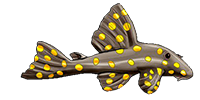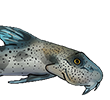Corydoras aurofrenatus vs Corydoras paleatus
-
mad scientist
- Posts: 87
- Joined: 24 Aug 2004, 04:17
- Location 1: Singapore
Corydoras aurofrenatus vs Corydoras paleatus
A shipment of Corydoras arrived 2 days ago with "C.aurofrenatus" on the import list. At first glance of the fish, I had thought that they are Corydoras paleatus.
From what I understand, these two are almost indistinguishable, apart from the fact that both male and female C. aurofrenatus have elongated dorsal fin spine (Seuss 1992).
This species seemed to be rather poorly described more than a century ago from one single specimen collected in Paraguay whilst C. paleatus by Jenyns about 40 years later.
Is there any definitive means of telling these two species apart, other than by means of the doral fin spine, which seems rather vague, if not unconvincing.
Very recently, Mr Joachim Knaack published an article "Bemerkungen zur Validität von Corydoras aurofrenatus und Corydoras latus" in Aquaristik aktuell 2004 vol 6, which discusses the validity of C. aurofrenatus and incidentally, C. latus Pearson 1924 as well. Could anyone possible share some insights discussed in the article?
Thanks a lot.
From what I understand, these two are almost indistinguishable, apart from the fact that both male and female C. aurofrenatus have elongated dorsal fin spine (Seuss 1992).
This species seemed to be rather poorly described more than a century ago from one single specimen collected in Paraguay whilst C. paleatus by Jenyns about 40 years later.
Is there any definitive means of telling these two species apart, other than by means of the doral fin spine, which seems rather vague, if not unconvincing.
Very recently, Mr Joachim Knaack published an article "Bemerkungen zur Validität von Corydoras aurofrenatus und Corydoras latus" in Aquaristik aktuell 2004 vol 6, which discusses the validity of C. aurofrenatus and incidentally, C. latus Pearson 1924 as well. Could anyone possible share some insights discussed in the article?
Thanks a lot.
Last edited by mad scientist on 10 Dec 2004, 02:35, edited 1 time in total.
- Coryman
- Expert
- Posts: 2119
- Joined: 30 Dec 2002, 19:06
- My articles: 12
- My catfish: 5
- My cats species list: 83 (i:3, k:0)
- My BLogs: 1 (i:0, p:46)
- Spotted: 194
- Location 1: Kidderminster UK
- Location 2: Kidderminster, UK
- Interests: Cory's, Loricariids, photography and more Cory's
- Contact:
Over the years there have been many names given to various forms of C. paleatus and without seeing a picture of the fish it would be virtually impossible to make any accurate assessment. C. aurofrenatus is very similar in colour to C. ehrhardti the main difference is that the former is a lot larger fish up to 70 mm sl, and is long snouted.
Ian
Ian
-
mad scientist
- Posts: 87
- Joined: 24 Aug 2004, 04:17
- Location 1: Singapore
Hi Ian,
Thanks for your reply.
I agree that there are several look-alike species e.g. C. ehrhardti and C. steindachneri. But it seems that they are not that difficult to tell apart from C. paleatus from snout-shape (as with C. steindachneri)and body markings (as with C. erhardti). But this is seemingly tougher with C. paleatus, whose body length can reach around 70 mm and body markings are very much like C. paleatus'.
Could you elaborate a bit more with the "long-snouted" character please? By that, do you mean that C. aurofrenatus' snout looks like that of C. acutus/C.cervinus? Or it is just a slight difference like we would observe between that of C. oiapoquensis and C. condiscipulus?
Thanks!
Alan
Thanks for your reply.
I agree that there are several look-alike species e.g. C. ehrhardti and C. steindachneri. But it seems that they are not that difficult to tell apart from C. paleatus from snout-shape (as with C. steindachneri)and body markings (as with C. erhardti). But this is seemingly tougher with C. paleatus, whose body length can reach around 70 mm and body markings are very much like C. paleatus'.
Could you elaborate a bit more with the "long-snouted" character please? By that, do you mean that C. aurofrenatus' snout looks like that of C. acutus/C.cervinus? Or it is just a slight difference like we would observe between that of C. oiapoquensis and C. condiscipulus?
Thanks!
Alan
- Coryman
- Expert
- Posts: 2119
- Joined: 30 Dec 2002, 19:06
- My articles: 12
- My catfish: 5
- My cats species list: 83 (i:3, k:0)
- My BLogs: 1 (i:0, p:46)
- Spotted: 194
- Location 1: Kidderminster UK
- Location 2: Kidderminster, UK
- Interests: Cory's, Loricariids, photography and more Cory's
- Contact:
Actually, as I said the body markings are NOT like C. paleatus they are more like C. ehrhardti. What is shown in Seuss is a C. paleatus species possibly C114. The etymology for C. eurofrenatus means 'Golden' 'Ear' a description that would no way fit C. paleatus.
I also do believe it to have an C. acutus type snout, may be not quit so prominent.
Ian
I also do believe it to have an C. acutus type snout, may be not quit so prominent.
Ian
-
mad scientist
- Posts: 87
- Joined: 24 Aug 2004, 04:17
- Location 1: Singapore
Would the etymology of the name be indicative of the body markings which this species has, i.e. "golden ear", like C. eques ?
About Seuss' publications, his later German folder book "Die faszinierende Welt der Corydoras" (1997) shows a completely different fish from the 1992 book, a long-nosed species and yes, as you've mentioned, "an C. acutus type snout, may be not quite so prominent". Interestingly, he made reference by comparing this species with C. ellisae and C. septentrionalis.
But the body markings of the species depicted in the 1997 book is not similar to that of C.ehrhardti's.
Perhaps a look at Eigenmann & Kennedy's original description of C. aurofrenatus would help? I'm also interested in what Knaack has mentioned in his recent article on this species.
About Seuss' publications, his later German folder book "Die faszinierende Welt der Corydoras" (1997) shows a completely different fish from the 1992 book, a long-nosed species and yes, as you've mentioned, "an C. acutus type snout, may be not quite so prominent". Interestingly, he made reference by comparing this species with C. ellisae and C. septentrionalis.
But the body markings of the species depicted in the 1997 book is not similar to that of C.ehrhardti's.
Perhaps a look at Eigenmann & Kennedy's original description of C. aurofrenatus would help? I'm also interested in what Knaack has mentioned in his recent article on this species.
- Silurus
- Posts: 12454
- Joined: 31 Dec 2002, 11:35
- I've donated: $12.00!
- My articles: 55
- My images: 896
- My catfish: 1
- My cats species list: 90 (i:1, k:0)
- Spotted: 428
- Location 1: Singapore
- Location 2: Moderator Emeritus








